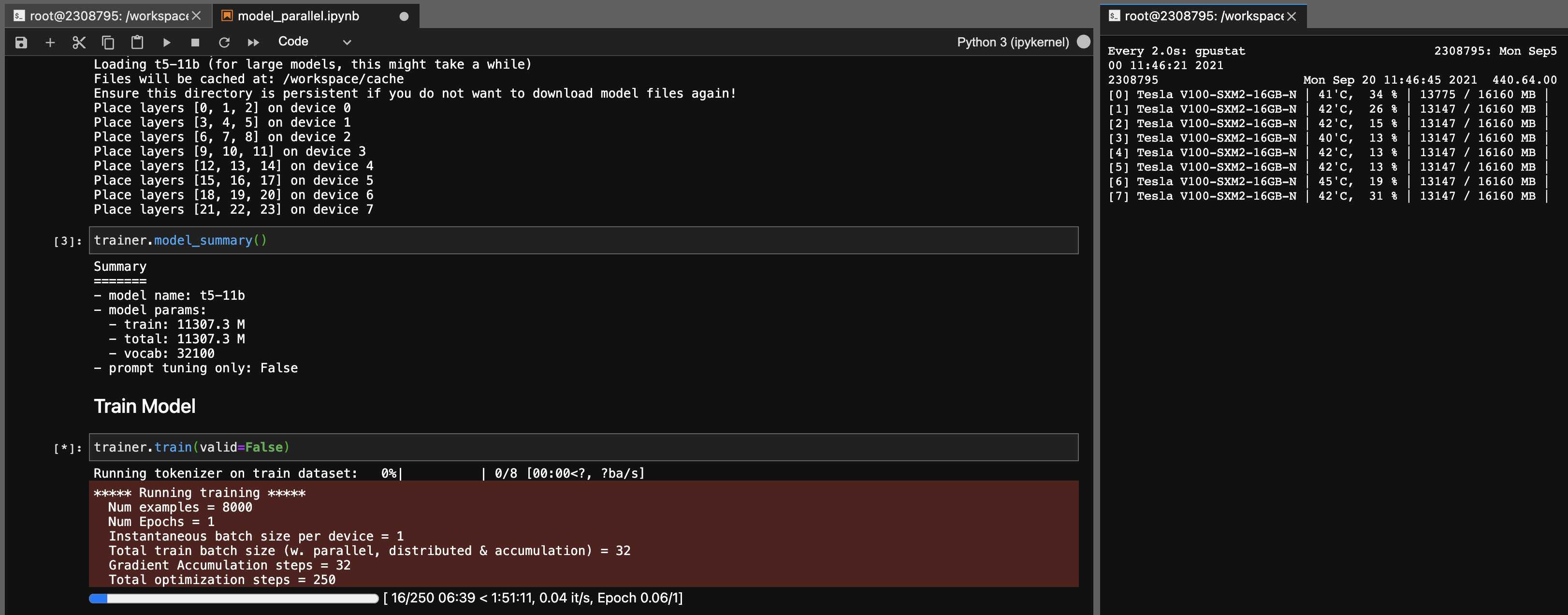t2t-tuner
Convenient Text-to-Text Training for Transformers
pip install t2t-tuner
Requires PyTorch: either follow PyTorch installation instructions or use a PyTorch container.
Features
- Easy training for text-to-text (and text generation) tasks
- Training methods/features:
- Supervised fine-tuning
- Gradient checkpointing
- Model parallelism
- Soft prompt tuning (based on this paper)
- Freeze encoder/decoder/embeddings
- Move embeddings to CPU
- Print model summary
- DeepSpeed
Based on the wonderful HuggingFace Transformers library. Tested on T5 and GPT type of models. In theory, it should work with other models that support AutoModelForSeq2SeqLM or AutoModelForCausalLM as well.
The Trainer in this library here is a higher level interface to work based on HuggingFace’s run_translation.py script for text-to-text generation tasks. I decided I want a more more convenient interface for training and inferencing, along with access to things like gradient checkpointing and model parallel to fit larger models - these are already in the HuggingFace library but not exposed in the script. I also added in some features that I wanted (prompt tuning, model summary), integrated it with autoregressive LM training and wrapped it as a single library that can be pip installed.
Examples
Training Models
import t2t
trainer_arguments = t2t.TrainerArguments(model_name_or_path="t5-small",
train_file=YOUR_DATASET)
trainer = t2t.Trainer(arguments=trainer_arguments)
# train without validation
trainer.train(valid=False)
For more concrete examples, check out the notebooks linked below:
Data Format
Seq2Seq Training
{"translation": {"s": "TEXT", "t": "LABEL"}}
- The format of data is json-lines, following HuggingFace original script. Each example is one line.
- Define the source and target IDs in
TrainingArguments.source_idandTrainingArguments.target_id(defaults tosandt). - Include the prefix in the data file, or define the prefix to prepend to the text in
TrainingArguments.prefix. - Example notebook for data preprocessing from CSV file
Autoregressive LM Training
- Any text file will work
Training Large Models
This section will outline how to train large language models (> 1 bil parameters) on relatively simple setups.
Some notes for the configurations reported below:
- GradCheckpoint: Gradient checkpointing to reduce VRAM usage, but increase computation (set
TrainerArguments.gradient_checkpointing). - FreezeEmbeds: Freeze (do not train) embedding layer to reduce VRAM usage and computation (set
trainer.freeze(embeddings=True)). - Adafactor uses less VRAM than Adam, but is slightly slower and can converge slightly differently.
- You can use gradient accumulation (
TrainingArguments.gradient_accumulation_steps) to make up to a larger batch size if needed. The batch sizes reported are without gradient accumulation. - Moving embeddings to CPU seems to have almost no impact on both VRAM usage and performance, therefore is not used.
GPT Models
Some GPT configurations that were tested to able to train on a single RTX 3090 (24GB) card (without DeepSpeed):
| Model | Params | Precision | Optimizer | InputLen | BatchSize | Other |
|---|---|---|---|---|---|---|
| gpt2 | 1.5b | FP16 | Adafactor | 128 | 4 | None |
| gpt2 | 1.5b | FP16 | Adafactor | 512 | 1 | None |
| gpt2 | 1.5b | FP16 | Adafactor | 1024 | 4 | GradCheckpoint |
| gpt-neo | 1.3b | FP16 | Adafactor | 1024 | 1 | None |
| gpt-neo | 1.3b | FP16 | Adafactor | 2048 | 4 | GradCheckpoint |
| gpt-neo | 2.7b | FP16 | Adafactor | 2048 | 4 | GradCheckpoint,FreezeEmbeds |
T5 Models
Some T5 configurations that were tested to able to train on a single RTX 3090 (24GB) card (without DeepSpeed):
| Model | Params | Precision | Optimizer | Seq2SeqLen | BatchSize | Other |
|---|---|---|---|---|---|---|
| t5 | 3b | FP32 | Adafactor | 128->128 | 1 | FreezeEmbeds |
| t5 | 3b | FP32 | Adafactor | 128->128 | 1 | GradCheckpoint |
| t5 | 3b | FP32 | Adafactor | 128->128 | 128 | GradCheckpoint,FreezeEmbeds |
| t5 | 3b | FP32 | Adafactor | 512->512 | 32 | GradCheckpoint,FreezeEmbeds |
Model Parallelism for T5-11b models
Using this library, you also can fine-tune the t5-11b checkpoints quite easily (single node) with the following settings (without Deepspeed):
- Suggested checkpoint: t5-11b
- Batch size 1 + gradient accumulation to make up to whatever batch size you need.
- Batch size of 8 is possible with gradient checkpointing, but doesn’t improve the speed.
- Model parallel across multiple GPUs:
- At least ~90 GB of VRAM
- Examples: 8x 16GB or 4x 32GB GPU (V100), or 2x 48GB (RTX8000/A6000)
- FP32 (no need for mixed precision/FP16)
- FP16 would actually be better, but the pretrained T5 checkpoints don’t play well with FP16.
- On Ampere cards (RTX30XX, A100, A6000), TF32 is used, which is faster than FP32 and doesn’t suffer from the same issues as FP16.
- Likely reason: the existing activations are too large (github issue tracking, some more info)

Note that depending on your system, the loading time for the checkpoint (46GB) can be very long. You’ll need ample CPU RAM (at least ~90GB) to load it successfully.
ONNX RT
ONNX RT works with some models (not T5, yet) and can provide a small boost in speed.
Install ORT, then set TrainingArguments.torch_ort=True
pip install torch-ort -f https://onnxruntimepackages.z14.web.core.windows.net/onnxruntime_stable_torch190.cu111.html
python -m torch_ort.configure
Development
Building Package
python3 -m pip install --upgrade build twine
python3 -m build
python3 -m twine upload dist/*
Disclaimers
This library as developed as a personal project for my own use. Please feel free to fork or use it for your own purposes as well. I will not take responsibility for any mishaps that occur as a result of this library’s usage.
Note for 3090 FE cards, if your fans hit 100%, it means your VRAM temps are high (>100 deg C). Training for long hours at these temperatures in theory should be fine, but if you want a peace of mind (like me), you can lower the power limit incur minor impact on training speeds. As long as your fans never hit 100%, your VRAM temperatures should be good. For example, to lower power limit to 300W (from 350W):
sudo nvidia-smi -pl 300